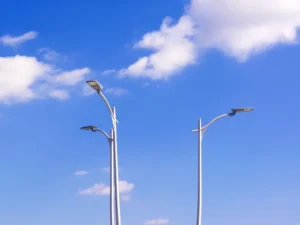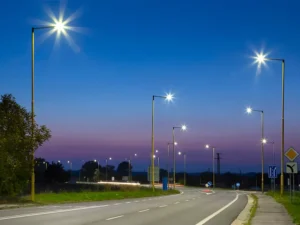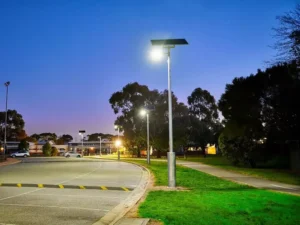Street lighting is a critical infrastructure in modern society, illuminating pedestrians, vehicle traffic, and public spaces. Over the years, street lighting has evolved, and new technologies and designs have emerged, making it more sustainable, energy-efficient, and visually appealing. In this article, we will explore some of the latest trends in street lighting and how they are transforming our cities and communities.
LED Technology Street Lighting

LED technology has become the standard for street lighting. It’s due to the energy efficiency, longevity, and low maintenance requirements. LED lights consume 80% less energy than conventional lights and last up to 100,000 hours, reducing the need for frequent replacement. As a result, many cities use LED lights to save on energy costs and maintenance while providing better lighting for residents.
In addition, LED lights can emit light of different color temperatures. Choose from warm white to cool white. It means that streetlight colors can match the aesthetics of the city. You can get a more inviting and cozy atmosphere by selecting a warmer color temperature. In comparison, you can get a more modern and sleeker look by choosing a cooler color temperature.
LÜKS produces one of the best LED street lights in the world. These quality LED outdoor lights are easy to install and maintain, making them popular with customers worldwide.
Akıllı Sokak Aydınlatması

Smart street lighting systems can adjust lighting levels based on traffic patterns, weather conditions, and other factors. This functionality is achieved through sensors and automation. For example, lights are dimmed to save energy during low-traffic periods. Lights are increased during periods of high traffic to improve visibility and safety. These systems can
- Reduce energy consumption
- Maintain costs
- Improve public safety and traffic flow
Smart streetlight systems can also be integrated with other smart city technologies. They connect traffic sensors to provide data on traffic patterns. Connect air quality monitors to provide data on air quality. Enables municipalities to make informed decisions about urban planning and resource allocation.
Solar-powered Street Lighting

Solar street lights are popular because of their sustainable and cost-effective solution. Solar panels power these lights and do not rely on electrical infrastructure, reducing energy costs. They are ideal for developing countries, especially for remote areas. Due to difficulty or cost, conventional lighting may not be viable in these areas.
Solar street lights also have a lower carbon footprint than traditional lights. They don’t use fossil fuels as an energy source, which helps cut carbon emissions and combat climate change.
Decorative Street Lighting
Decorative street lighting is a way to enhance a community’s aesthetic appeal. In recent years, they have gained popularity in urban areas These lights come in various designs and styles, from classic to modern. It’s possible to tailor streetlights to complement the appearance and atmosphere of the surrounding vicinity. People’s aesthetic requirements will be met as a result. Decorative street lights can also be used to highlight historical or cultural landmarks. Decorative streetlights enhance ambiance and create an engaging experience for visitors. In addition, pedestrians feel safer and more comfortable when walking at night.
Wireless Control System
Wireless control systems enable municipalities to monitor and adjust street lighting levels remotely. This technology can
- Reduce maintenance costs
- Improve energy efficiency
- Identify and resolve lighting system problems
- Provide real-time data (energy consumption, traffic patterns, and other factors)
- Help municipalities make informed decisions about street lighting
Furthermore, wireless control systems can integrate with various smart city technologies. It connect with traffic management systems to provide data on traffic patterns. Combined with public safety sensors offers valuable data about public safety. Thus, municipalities can make more informed decisions about urban planning and resource allocation.
Sonuç
The latest trends in street lighting reflect a growing concern for sustainability, energy efficiency, and visual appeal.
- LED Technology
- Intelligent Systems
- Solar lights
- Decorative designs
- Wireless control systems
These are just a few examples of the latest advances in street lighting. By adopting these technologies, municipalities can create safer, more sustainable, visually appealing urban environments for their residents.
LÜKS has been operating for over two decades, specializing in the research and development of outdoor LED lighting. As a comprehensive LED manufacturing company, they cover the whole spectrum of R&D, production, sales, and service. Their product line includes an extensive selection of LED street lights and garden lighting, catering to diverse outdoor applications, including municipal, commercial, residential, and hotel projects.
If you want to learn more about street lighting, visit the website: https://luxificlighting.com/. We are always ready to provide valuable answers.